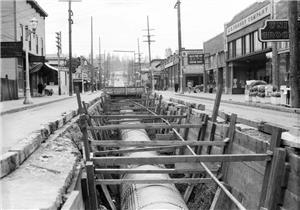On February 7, 1905, the City of Seattle enters into a contract to sell the Town of Renton water drawn from Seattle's newly built Cedar River Water System. The pipeline from the Cedar River passes beneath Renton on its way to Seattle. In 1931, Seattle will again impose upon Renton to replace pipelines that run under the town.
Cedar River
The Cedar River Pipeline is a major piece of infrastructure which draws off water from the Cedar River. Now, more than a century after the first water was delivered to Seattle residents in 1901, the system takes about 18 percent of the river’s flow to provide close to 70 percent of the city’s water supply. (The Tolt River provides the remaining 30 percent.) The Cedar River Pipeline is now a series of four major channels bringing water into the city from Southeast King County.
Often overlooked in the telling is the impact of the pipelines on the city of Renton, the largest population center between the headworks of the water system at Landsburg, 28 miles southeast of Seattle, and the metropolis. While the Cedar River runs through Renton, three of the four pipelines run under Renton, two of them right down Third Avenue, a main artery. Neither the river nor the pipelines provides water to Renton itself, with one small exception.
The Waters of Renton
The bulk of Renton’s water today (61 percent in 2021) comes from the Cedar Valley Aquifer that fills the city’s six wells in Liberty Park and Cedar River Park. A small spring in South Renton and a wellfield under the Maplewood Golf Course supply the remainder.
Since 1905 various agreements with Seattle water utility (Seattle Water Department; later, Seattle Public Utilities) have supplied Renton with an additional source of purchased water during summer dry periods. Seattle water also supplies the Boeing plant in North Renton. Currently, Seattle water accounts for much less than 1 percent of Renton’s total.
The 1905 agreement was somewhat controversial. Voices in the media claimed that Renton was getting a sweetheart deal, paying less per gallon of water than Seattle customers. One article notes that Renton had "paid not one penny toward construction of the municipal water plant" ("Local Consumers"). The contract with Renton for surplus water was just one of many Seattle made with unincorporated areas, such as Georgetown and Ballard.
Tearing up the Town
In 1931, Seattle replaced some of the 42-inch pipes with 66-inch pipes. Seattle paid Renton $30,000 in cash as compensation for allowing it to dig up Renton streets in order to replace the ducts. Renton had turned down an earlier offer from Seattle for $15,000 and the repaving of Third Avenue, electing to do the work itself while also installing a storm sewer alongside the pipeline.
For some four months of 1931, Renton and its merchants endured while the main drag was torn up and then paved over. In June of that year, Mayor G. W. Beanblossom announced that the repaving was almost complete and a celebration was planned for June 27. The event went forth with great fanfare featuring bathing beauties, a pet parade, a roller-skating contest, street dancing, and, of course, speeches. "Tremendous bargains" from local merchants rounded out the festivities ("All Roads").
In the words of the Renton Chronicle, "It took more than a tied-up street to put the old town out of business. It took more than a pipeline to finish off the merchants along the avenue. And while the way was long and tedious, and the sky dark and lowering, there was the old fight left all the time" ("Third Avenue Open").

